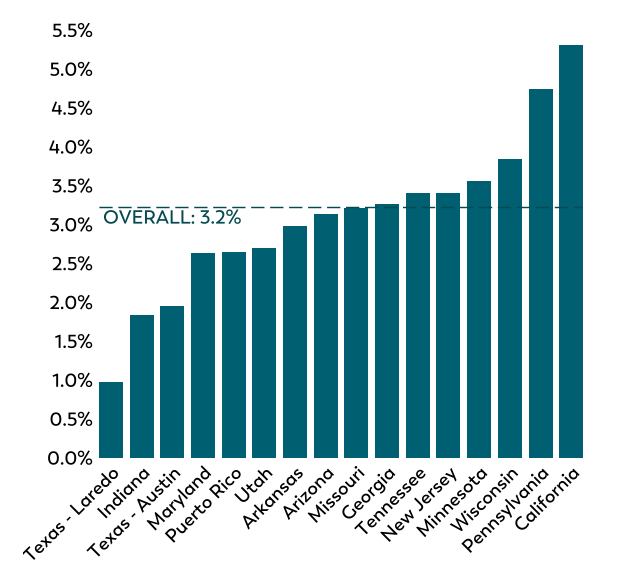What to know
CDC’s Autism and Developmental Disabilities Monitoring (ADDM) Network is the only collaborative network to track the number and characteristics of children with autism spectrum disorder (ASD) and cerebral palsy (CP) in different communities in the United States. CDC encourages partners to use information from ADDM in their local communities and across the country to move forward initiatives, systems, and research that help children and families living with ASD and CP.

What do ADDM data tell us about ASD?
- About 1 in 31 (3.2%) 8-year-old children living in ADDM Network sites were identified with ASD. This estimate is based on 8-year-old children living in 16 ADDM Network communities in 2022 and does not necessarily represent the entire population of children in the United States.1
- ASD prevalence and identification practices varied widely across ADDM Network sites in 2022. Prevalence rates ranged from 1 in 103 in Texas (Laredo) to 1 in 19 in California. CDC's ADDM Network also found differences in testing practices and evaluation among communities.

- Certain children are more likely to be identified with ASD. Among 8-year-old children, boys were more than 3 times as likely as girls to be identified with ASD. In addition, the percentage of 8-year-old Asian or Pacific Islander, American Indian or Alaska Native, Black, Hispanic, and Multiracial children identified with ASD was higher than among 8-year-old White children.
- Intellectual disability (ID) is often seen in children with ASD and can indicate a type of impairment in intellectual ability. Among 8-year-old children identified with ASD who had a documented intelligence quotient (IQ) score, nearly 40% also had ID (IQ scores equal to or less than 70).
- Increases in early identification of ASD continue. Overall, children born in 2018 were nearly 2 times as likely as children born in 2014 to be identified as having ASD by 4 years of age.

- Higher rates of evaluations and ASD identifications in younger children resumed following COVID-19 disruption. During their first 4 years of life, children born in 2018 had more evaluations and ASD identifications than children born in 2014. This overall pattern of higher rates of evaluations and ASD identifications in younger children over time was briefly disrupted during the COVID-19 pandemic but resumed by the end of 2020. It is important to note that we do not have a way of knowing what the pattern might have been without the onset of COVID-19.
Different approaches to improve ASD identification and services
Successful community and state-level approaches to early ASD identification and service eligibility can serve as lessons learned and help children and families in all communities receive the services and support they need as early as possible. ADDM Network sites offer examples of successful initiatives helping to improve ASD identification and access to services across communities. Find out more about different approaches across ADDM communities in CDC's 2025 Community Report on Autism.
Strengthening public health infrastructure for ASD and CP
To understand the public health impact of developmental disabilities in the United States, Congress passed the Children's Health Act of 2000, which paved the way for CDC to create the ADDM Network, helping to better track the number and characteristics of children with ASD and other developmental disabilities in different communities over many years.
Using CDC's Metropolitan Atlanta Developmental Disabilities Surveillance Program (MADDSP) as a model, the ADDM Network has now been collecting and reporting ASD data from across the United States since the Children's Health Act was passed — while also gathering information on other developmental disabilities, such as cerebral palsy (CP).
There are several major advantages to using the ADDM method for tracking the number and characteristics of children with ASD and CP:
- The ADDM method is population-based. CDC monitors ASD and CP among thousands of children from different communities across the United States.
- ADDM tracks how many children have ASD and CP, which groups of children are more likely to be identified with ASD or CP, and at what age they are likely to be diagnosed.
- ADDM findings reflect real-world community practices. Differences in ASD and CP identification among communities suggest opportunities to identify and serve all children with ASD and CP.
CDC's ADDM Network sites offer resources and information on ASD and CP for parents, community leaders, and healthcare providers – find more information closest to your community.
Future directions
CDC will continue to monitor the number and characteristics of children with ASD and CP and track progress in the early detection of ASD and CP over time. ADDM Network sites also monitor health and transition planning needs among 16-year-old adolescents with ASD. States and communities have the potential to turn ADDM Network data into action. These findings can be used in local communities and nationwide to advance initiatives, systems, and research that help all children with ASD and CP.
Learn More
- CDC's Autism and Developmental Disabilities Monitoring Network
- CDC's "Learn the Signs. Act Early." program offers free resources to help families and professionals monitor children's early development.
- Facts About CDC's ADDM Network
- Shaw KA, Williams S, Patrick ME, et al. Prevalence and Early Identification of Autism Spectrum Disorder Among Children Aged 4 and 8 Years — Autism and Developmental Disabilities Monitoring Network, 16 Sites, United States, 2022. MMWR Surveill Summ 2025;74(No. SS-2):1–22.